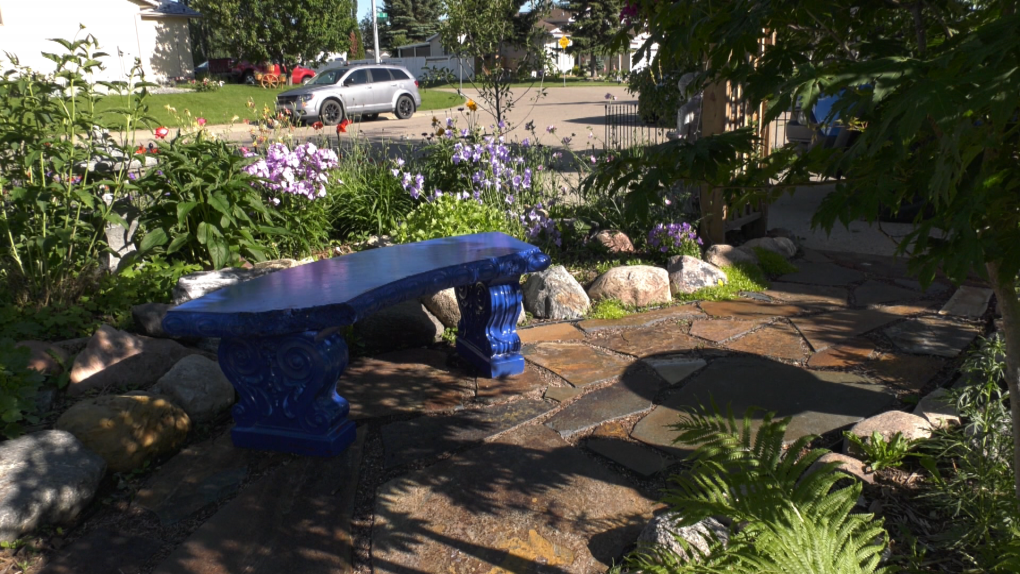No grass, no problem: Why some Edmontonians are looking for lawn alternatives
Over the past two years, Crawford Plains resident Johann Brown has gotten rid of his front lawn, and besides the back-breaking work of doing it by hand, he loves it.
"I come out here and have coffee in the morning on the weekend," he told CTV News Edmonton.
"In the evening, it's definitely a place to come and sit and get some shade in July sun. So Saturday, Friday nights I spend on the deck."
During the summers of the pandemic, bit by bit, he replaced the grass in front of his house on 45 Street with a deck, flagstone path, and flower beds and wildflowers. He had no long-term vision, just a goal of having coffee on a deck in the mornings.
It was an expression of creativity, and a hallmark from his childhood days gardening with his grandmother.
But it also was a choice of efficiency.
"I find grass is somewhat overrated, especially front lawns. Mostly it's your neighbours that get to enjoy it," Brown said.
 Since 2020, Crawford Plains resident Johann Brown was replaced the grass in his front yard with a deck, flagstone path, and flowers, changes he says are much more enjoyable than a high-maintenance lawn.
Since 2020, Crawford Plains resident Johann Brown was replaced the grass in his front yard with a deck, flagstone path, and flowers, changes he says are much more enjoyable than a high-maintenance lawn.
Local garden centre Apache Seeds says Brown is part of a trend that started around 2014: home owners wanting to replace their lawn for financial, time-saving and environmental reasons.
"If you have animals, you know, that one spot in your yard will always be filled with yellow spots," sales associate Julia Bowen explained. "[Grass] can sometimes get worn down really easily. Grass struggles in some shaded areas under evergreen trees, things like that. So if you have trampolines, ice rinks in your yard, kids, parties, decks… Grass is also tough if you have allergies. It's not the greatest for bees.
"Grass is just a lot of work."
In recent years, the store has seen increased demand for alternatives like microclover and White Dutch clover, both of which are fast-spreading short green plants that are hardier than grass.
"This is probably the third time this season that we've been sold out of miroclover," Bowen said. "People have been starting to either incorporate into part of their lawn, or replace their lawn entirely…. Same with the White Dutch. We still have some of that in stock, but it has been going quite fast."
Expecting demand to still be high in the fall when the temperature is cool enough to plant clover, the store is currently sourcing more seeds of both.
White Dutch clover grows about six inches tall, and requires less mowing than grass. Microclover only grows two to three inches tall. While it still needs to be mowed, like White Dutch clover, microclover is very hardy, weed and drought resistant, and naturally draws more nitrogen into the soil.
"Five per cent clover has become quite popular, too. If you mix in a little bit of clover with your grass seed, it helps to fill in those spots that grass can't exactly," Bowen said.
Although he didn't use any microclover in his design, Brown understands the appeal of opting out of so much lawn.
"There's benefits like no mowing grass, no having to maintain grass. The drawbacks: maybe more weeds to pull?" he shrugged.
But, he pointed out, "There's a lot you can do to make it more beautiful and eco-friendly."
With files from CTV News Edmonton's Jessica Robb and Brandon Lynch
CTVNews.ca Top Stories

Montreal man dead after boat explodes in Fort Lauderdale
A Montreal man is dead and several others are injured after a boat exploded in Fort Lauderdale, Florida.
Mother-daughter duo pursuing university dreams at the same time
For one University of Windsor student, what is typically a chance to gain independence from her parents has become a chance to spend more time with her biggest cheerleader — her mom.
Azerbaijani airliner crashes in Kazakhstan, killing 38 with 29 survivors, officials say
An Azerbaijani airliner with 67 people onboard crashed Wednesday near the Kazakhstani city of Aktau, killing 38 people and leaving 29 survivors, a Kazakh official said.
Historical mysteries solved by science in 2024
This year, scientists were able to pull back the curtain on mysteries surrounding figures across history, both known and unknown, to reveal more about their unique stories.
King Charles III focuses Christmas message on healthcare workers in year marked by royal illnesses
King Charles III used his annual Christmas message Wednesday to hail the selflessness of those who have cared for him and the Princess of Wales this year, after both were diagnosed with cancer.
Alberta premier hopes for health reform payoff in 2025, regrets deferring tax cut
"It may have been better for Albertans if we'd implemented and then found a way to be able to pay for it."
Second storm incoming for Christmas Day in southern B.C.
Environment Canada has issued a new series of weather warnings for British Columbia’s south coast Christmas morning.
Pope urges 'all people of all nations' to silence arms and overcome divisions in Christmas address
Pope Francis in his traditional Christmas message on Wednesday urged 'all people of all nations' to find courage during this Holy Year 'to silence the sounds of arms and overcome divisions' plaguing the world, from the Middle East to Ukraine, Africa to Asia.
What is Christmas like for Quebec health-care workers who stay on the job?
Most Quebecers get together with family and friends on Christmas Eve, but many professions require people to remain on the job at all times, including health-care workers.






























